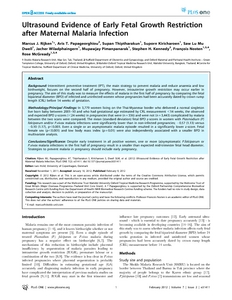Rijken, MJ; Papageorghiou, AT; Thiptharakun, S; Kiricharoen, S; Dwell, SL; Wiladphaingern, J; Pimanpanarak, M; Kennedy, SH; Nosten, F; McGready, R
(2012)
Ultrasound evidence of early fetal growth restriction after maternal malaria infection.
PLOS ONE, 7 (2).
e31411.
ISSN 1932-6203
https://doi.org/10.1371/journal.pone.0031411
SGUL Authors: Papageorghiou, Aris
![[img]](https://openaccess.sgul.ac.uk/1808/1.hassmallThumbnailVersion/pone.0031411.pdf)  Preview |
|
["document_typename_application/pdf; charset=binary" not defined]
Published Version
Download (269kB)
| Preview
|
Abstract
BACKGROUND: Intermittent preventive treatment (IPT), the main strategy to prevent malaria and reduce anaemia and low birthweight, focuses on the second half of pregnancy. However, intrauterine growth restriction may occur earlier in pregnancy. The aim of this study was to measure the effects of malaria in the first half of pregnancy by comparing the fetal biparietal diameter (BPD) of infected and uninfected women whose pregnancies had been accurately dated by crown rump length (CRL) before 14 weeks of gestation.
METHODOLOGY/PRINCIPAL FINDINGS: In 3,779 women living on the Thai-Myanmar border who delivered a normal singleton live born baby between 2001-10 and who had gestational age estimated by CRL measurement <14 weeks, the observed and expected BPD z-scores (<24 weeks) in pregnancies that were (n = 336) and were not (n = 3,443) complicated by malaria between the two scans were compared. The mean (standard deviation) fetal BPD z-scores in women with Plasmodium (P) falciparum and/or P.vivax malaria infections were significantly lower than in non-infected pregnancies; -0.57 (1.13) versus -0.10 (1.17), p<0.001. Even a single or an asymptomatic malaria episode resulted in a significantly lower z-score. Fetal female sex (p<0.001) and low body mass index (p = 0.01) were also independently associated with a smaller BPD in multivariate analysis.
CONCLUSIONS/SIGNIFICANCE: Despite early treatment in all positive women, one or more (a)symptomatic P.falciparum or P.vivax malaria infections in the first half of pregnancy result in a smaller than expected mid-trimester fetal head diameter. Strategies to prevent malaria in pregnancy should include early pregnancy.
| Item Type: |
Article
|
| Additional Information: |
PMCID: PMC3276538
©2012 Rijken et al. This is an open-access article distributed under the terms of the Creative Commons Attribution License, which permits unrestricted use, distribution, and reproduction in any medium, provided the original author and source are credited. |
| Keywords: |
Adult, Female, Fetal Growth Retardation, Gestational Age, Humans, Malaria, Malaria, Falciparum, Malaria, Vivax, Pregnancy, Ultrasonography, Prenatal, Young Adult |
| SGUL Research Institute / Research Centre: |
Academic Structure > Institute of Medical, Biomedical and Allied Health Education (IMBE)
Academic Structure > Institute of Medical, Biomedical and Allied Health Education (IMBE) > Centre for Clinical Education (INMECE ) |
| Journal or Publication Title: |
PLOS ONE |
| ISSN: |
1932-6203 |
| PubMed ID: |
22347473 |
| Web of Science ID: |
22347473 |
| Dates: |
| Date |
Event |
| 2012-02-09 |
Published |
|
  |
Download EPMC Full text (PDF)
|
 |
Download EPMC Full text (HTML)
|
 |
Go to PubMed abstract |
| URI: |
https://openaccess.sgul.ac.uk/id/eprint/1808 |
| Publisher's version: |
https://doi.org/10.1371/journal.pone.0031411 |
Statistics
Item downloaded times since 01 May 2012.
Actions (login required)
 |
Edit Item |




